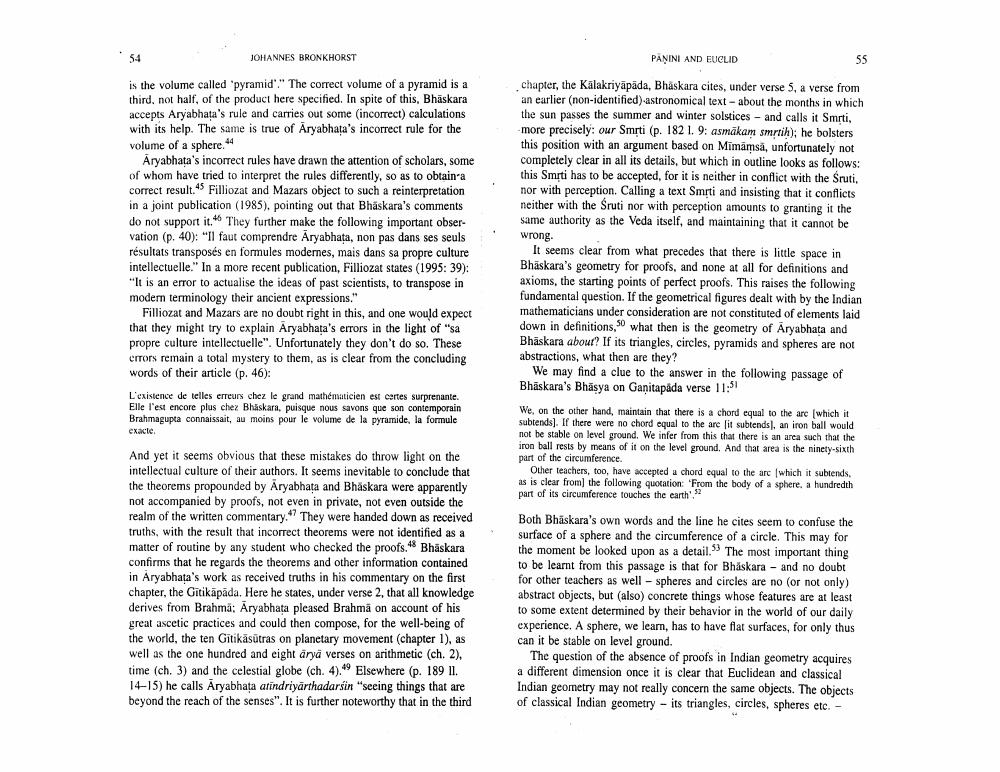Book Title: Panini And Euclid Reflections On Indian Geometry Author(s): Johannes Bronkhorst Publisher: Johannes Bronkhorst View full book textPage 7
________________ JOHANNES BRONKHORST PANINI AND EUCLID is the volume called "pyramid"." The correct volume of a pyramid is a third, not half, of the product here specified. In spite of this, Bhaskara accepts Aryabhata's rule and carries out some incorrect) calculations with its help. The same is true of Aryabhata's incorrect rule for the volume of a sphere 44 Aryabhata's incorrect rules have drawn the attention of scholars, some of whom have tried to interpret the rules differently, so as to obtain a correct result.45 Filliozat and Mazars object to such a reinterpretation in a joint publication (1985), pointing out that Bhaskara's comments do not support it. They further make the following important observation (p. 40): "Il faut comprendre Aryabhata, non pas dans ses seuls résultats transposés en formules modernes, mais dans sa propre culture intellectuelle. In a more recent publication, Filliozat states (1995: 39): "It is an error to actualise the ideas of past scientists, to transpose in modem terminology their ancient expressions." Filliozat and Mazars are no doubt right in this, and one would expect that they might try to explain Aryabhata's errors in the light of "sa propre culture intellectuelle". Unfortunately they don't do so. These crrors remain a total mystery to them, as is clear from the concluding words of their article (p. 46): chapter, the Kālakriyapada, Bhaskara cites, under verse 5. a verse from an earlier (non-identified) astronomical text-about the months in which the sun passes the summer and winter solstices - and calls it Smrti, - more precisely: our Smrti (p. 182 1. 9: asmäkam smrtih); he bolsters this position with an argument based on Mimamsă, unfortunately not completely clear in all its details, but which in outline looks as follows: this Smrti has to be accepted, for it is neither in conflict with the Sruti. nor with perception. Calling a text Smrti and insisting that it conflicts neither with the Sruti nor with perception amounts to granting it the same authority as the Veda itself, and maintaining that it cannot be wrong. It seems clear from what precedes that there is little space in Bhaskara's geometry for proofs, and none at all for definitions and axioms, the starting points of perfect proofs. This raises the following fundamental question. If the geometrical figures dealt with by the Indian mathematicians under consideration are not constituted of elements laid down in definitions So what then is the geometry of Aryabhata and Bhaskara about? If its triangles, circles, pyramids and spheres are not abstractions, what then are they? We may find a clue to the answer in the following passage of Bhaskara's Bhäsya on Ganitapada verse 11:3 L'existence de telles erreurs chez le grand mathématicien est certes surprenante. Elle l'est encore plus chez Bhaskara, puisque nous savons que son contemporain Brahmagupta connaissait, au moins pour le volume de la pyramide, la formule exacte We, on the other hand, maintain that there is a chord equal to the arc (which it subtends). If there were no chord equal to the arc fit subtends, an iron ball would not be stable on level ground. We infer from this that there is an area such that the iron ball rests by means of it on the level ground. And that area is the ninety-sixth part of the circumference. Other teachers, too, have accepted u chord equal to the arc (which it subtends as is clear from the following quotation: "From the body of a sphere. a hundredth part of its circumference touches the earth.52 And yet it seems obvious that these mistakes do throw light on the intellectual culture of their authors. It seems inevitable to conclude that the theorems propounded by Aryabhata and Bhaskara were apparently not accompanied by proofs, not even in private, not even outside the realm of the written commentary. They were handed down as received truths, with the result that incorrect theorems were not identified as a matter of routine by any student who checked the proofs." Bhaskara confirms that he regards the theorems and other information contained in Aryabhata's work as received truths in his commentary on the first chapter, the Gitikāpāda. Here he states, under verse 2, that all knowledge derives from Brahma: Aryabhata pleased Brahmä on account of his great ascetic practices and could then compose, for the well-being of the world, the ten Gitikasutras on planetary movement (chapter 1), as well as the one hundred and eight arya verses on arithmetic (ch. 2). time (ch. 3) and the celestial globe (ch. 4)." Elsewhere (p. 189 11. 14-15) he calls Aryabhata atindriyarthadarsin "seeing things that are beyond the reach of the senses". It is further noteworthy that in the third Both Bhaskara's own words and the line he cites seem to confuse the surface of a sphere and the circumference of a circle. This may for the moment be looked upon as a detail. The most important thing to be learnt from this passage is that for Bhaskara - and no doubt for other teachers as well - spheres and circles are no (or not only) abstract objects, but also) concrete things whose features are at least to some extent determined by their behavior in the world of our daily experience. A sphere, we learn, has to have flat surfaces, for only thus can it be stable on level ground. The question of the absence of proofs in Indian geometry acquires a different dimension once it is clear that Euclidean and classical Indian geometry may not really concern the same objects. The objects of classical Indian geometry - its triangles, circles, spheres etc. -Page Navigation
1 ... 5 6 7 8 9 10 11 12 13 14 15 16 17 18 19 20
